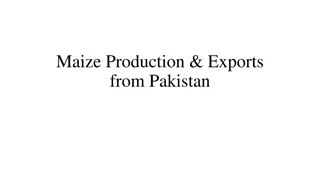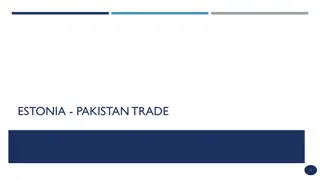Evolution of Urban Community Development in Pakistan
Urban Community Development in Pakistan began as an experimental fieldwork practice in 1952-53, with the first project in Haji Dilboth Goth focusing on improving women and children's health. Challenges arose in applying rural community development methods to urban areas. The second project in Lyari faced initial skepticism but gained community trust with the help of a United Nations consultant. The projects marked significant milestones in the history of community development in Pakistan.
Download Presentation

Please find below an Image/Link to download the presentation.
The content on the website is provided AS IS for your information and personal use only. It may not be sold, licensed, or shared on other websites without obtaining consent from the author. Download presentation by click this link. If you encounter any issues during the download, it is possible that the publisher has removed the file from their server.
E N D
Presentation Transcript
History of Community Development in Pakistan: Urban Community Development (UCD)
Urban Community Development started in Pakistan as a learning experiment for the trainees of the first in-service training course in 1952-53. In fact, it was an experimental field work practice in an programme. There was no fixed plan, no design, no definitions guidelines. experimental training nor any written
Haji Dilboth Goth: 1stCommunity Development Project (Also known as Demonstration Project) A village named Haji Dilboth Goth, named after the village elder. He invited them to start a program to help improve the health of women and children. 21 Kilometers from Karachi was selected as the first Community Development Project.
Challenges: The challenge was to demonstrate that the community development were being tried out in rural areas could also be applied to urban and semi-rural areas. Unlike the V-Aid program in which finances were abundant, the team entered the village with empty hands methods which
Lyari UCDP: 2ndUrban Community Development Project: At the completion of first CDP in April 1953, the beginning of the second course at Dhaka in start of 1954, another field work site was to be selected for the self-help experiment. So, Ms. Lucke and Begum Wajid Khan went touring the slums of Karachi, where they select Lyari.
Before selected the place: They have decided to seek the permission of Chief Officer of the Karachi Municipal Corporation, Mr. Howroyd. He briefed them that it the home of criminals, thieves, the underworld people, and full of faith. It is a Hornet s Nest. However, if you are still determined to go into the Hornet s Nest, you have my blessing and fullest co-operation .
Thus, it was selected as the 2ndUCDP. Toward the end of 1953, the United Nations consultant for UCD, Mr. Abdul Monem Shawky, arrived Karachi and joined the team. Being a Muslim, he was immediately accepted and welcomed. His broad smile, a resounding Arabic As- Salamalaikum and a hearty handshake, was heart winning and greeted with equal gusto by the Lyarities. He won over their confidence and friendship.
Lyari Community Development Council: Initially, it was very difficult to convince the people for their participation, however, when they realized that they have no political motive, they accepted and start work with them. Lyari was divide into five sub-areas: 1. Gharibabad 2. Kumharwara 3. Chakiwara 4. Iqbal Colony 5. Kalankot
Each village was represented by 2 members. Lyari citizens Advisory Council came into being. Each area committee started activities in their own areas which were reported to the Council.
Community Development Approach: Mr. Masihudeen Mirza, an active trainee worker, expressed his views by listing the following: We help the exiting groups (associations) in Lyari to do a better job. We encourage people to start new groups to meet existing problems. We train people to be more conscious of their needs and resources. Sometime we hold a demonstration to show a need We help them to co-ordinate and co-operate for service to the community as a whole and encourage democratic participation.
Activities of the Council: The Lyari Citizens Advisory Council raised more than Rs. 5000/- to finance some of the welfare services Iqbal Colony: Rs. 5000/- Kalankot Committee Rs. 2000/- Chakiwara Committee Rs. 18,000/- Kumharwara Committee collected Rs. 3000/- The Gharibabad collected Rs. 425 for night schools.
Misri Shah Project, Lahore In November 1954: two year post-graduate diploma course in Social work was started at Lahore In Punjab University, later become a Master Program in Social Work). It was same project based on the experience of Lyari CDP.
Kayettuly Project, Dhaka In May, 1955, a nine month training course was started in Dhaka, which lasted until February 1956.
URBAN COMMUNITY DEVELOPMEBNT IN THE FIRST FIVE YEAR PLAN (1955-60): 70 Community Development Project: were proposed in the First Five Plan (1955-60) for which Rs. 1.33 million were provided to employ trained social workers. Similarly, 1954, the sanctioned 6 posts of social workers to undertake community development projects in Lyari and other cities of East and West Pakistan. Govt of Pakistan
The Village Agricultural and Industrial Development (V-AID) Program, 1953-1962 In Pakistan, after the visit of a group of the Pakistani government officials to the United States to study the rural extension work in 1951, it was decided to adapt the American extension model to the conditions in Pakistan with the financial and technical assistance from the United States.
It was suggested that Pakistan needed: to identify things that villagers needed, and to bring the different nation-building government departments together to meet the needs. All of these ideas were packaged into the, Village Agricultural development (V-AID) Program in 1953. and Industrial
The officially stated objectives of the V-AI D Program were to: Increase the output of agriculture and village industries for higher rural incomes. Provide more water, schools, health care centers, and other social and creational facilities.
The activities included in the Program were: Improvement in crop and livestock production. Building roads, bridges, culverts, schools, wells, and drains. Planting trees. And removing health hazards.
The village councils were appointed and not elected by the villagers. The government organization and villagers in each Development Area was the Village AID worker - a multipurpose extension agent trained for one year in a government V-AID training institute. most important link between the
Each Village-AID worker was expected to supervise 5-7 villages, or there were about 30 Village-AID workers in each Development Area. The Village-AID worker was supposed to act as a guide, philosopher and friend to the villagers and his functions included education, organization, motivation, formation of all purpose village councils, modernization of, agriculture, improvement in health facilities, building roads, giving marketing and generating self-help. credit, arranging
The Basic Democracies System (BDS), 1963 - 1973 It came on scene in 1959 it was designed to bring the elements of community development and political development together, especially at the local level. The government development tiers different levels: The lowest tier was a union council, a group of villages comprising 12-15 village councilors. administrative were organized and into
On an average, such a union council covered a population of 8,000. The councils carried out social and economic development work in their respective areas. The problems that the union councils tried to solve were related to education, infrastructure, agriculture and sanitation.
The BDs went a long way in developing awareness and local leadership among the rural masses but the change in the Government in 1970 saw the abolition of the BDS and the introduction of a new Rural Development Approach (the Integrated. Rural Development Program) (IRDP).
The Rural Works Program 1963-1972 The Rural Works Programme (RWP) had its origins in a pilot project for community development undertaken by the late Akhter Hameed Khan as Director of the Pakistan Academy for Rural Development (PARD) in Comilla (now in Bangladesh).
He experimented with a pilot project in which the rural communities with the assistance completed capital works, link roads, subsidiary irrigation channels, etc. to promote agricultural growth and provide rural employment. of government
The basic purpose of the pilot project in Comilla was to assess the capability of the village people, basic democracies and the local government officials to undertake sizable development programs in their respective areas. the working out of implementation and maintenance of the project works. the procedure for
The officially announced objectives of RWP were to: Provide increased employment in rural areas on local projects not requiring large investments and their benefits can be easily recognized by the workers. Create infrastructure such as roads, bridges, irrigation .channels, etc. in rural areas.
Create an effective nucleus of planning and development at the local (Union Council) level and associate increasing segment of the population in the development effort. Mobilize human and financial resources for the implementation of local projects through taxation and voluntary labor.
While it was decide to execute RWP primarily by the basic democracy institutions, the overall administrative control and supervision of the program was government with the close association and guidance of concerned officials at all levels. exercised by the In the provinces, the governments created Directorate of Projects for RWP in the Departments of Basic Democracies and Local Government (BDLG).
In the field, the Deputy Commissioners were designated as controlling officers to organize and supervise the execution of the program in the districts. Directors of Basic Democracies were assigned in various departments for the supervision and evaluation of the program.
The Sub-Divisional Officers (SDOs) were given control of the Union Councils and Tehsil I Taluka Councils. The Union Council Chairman, representing about 10,000 people, became an important elected official in the RWP. The representation of rural people in the Basic Democracy institutions ineffective by the Tehsil/Taluka and District Councils and the role of appointed officials. was structure made more the of
Some experts have regarded the program as a "successful innovation in rural development" because it: Led to the completion of over 60,000 projects in a variety of rural infrastructure and services; the average cost of these projects was much lower than those constructed by the government departments. Mobilized local contribution, in labor, land, cash, to the extent of about 15 per cent of the total cost of all projects.
Provided jobs right where the people lived and reduced underemployment or seasonal unemployment in rural areas. Improved the village infrastructure like irrigation channels, drains and embankments created awareness among the people about the development needs and induced them to prepare plans.
Local Government & Rural Development Department (LG&RDD), 1978 In 1978-79 Local Government and Rural Development Department was established by integrating/merging Peoples Works Program and Development Program. Integrated Rural
Since 1978, Local Government and Rural Development Department is working for socio-economic uplift of rural population (88%) of the Sate of Azad Jammu & Kashmir.
Besides Program, LG&RDD is also working as line department for implantation of many projects funded agencies/donors, such as (World Bank, IDA, UNICEF, FAO, Asian Development Bank etc.) for socio-economic uplift of rural population facilities and rural LG&RDD is responsible for: the Annual Development by international by providing infrastructure. basic
To prepare and implement development programs for rural areas. To uplift socio-economic condition of rural masses. To implement Annual Development Program donor assisted projects as agreed by Government of AJ&K. To promote and utilize local resources. To mobilize and organize rural masses for participatory rural development.




